
Mitchella is a genus of flowering plants in the family Rubiaceae. It is found from China to temperate eastern Asia, and from eastern Canada to Guatemala.

Stewartia is a genus of 8-20 species of flowering plants in the family Theaceae, related to Camellia. Most of the species are native to eastern Asia in China, Japan, Korea, Laos, Myanmar, Thailand, and Vietnam, with two in southeast North America, from Virginia and Kentucky south to Florida and Louisiana.

Myrica rubra, also called yangmei, yamamomo, Chinese bayberry, red bayberry, yumberry, waxberry, or Chinese strawberry is a subtropical tree grown for its fruit.

Weigela is a genus of between six and 38 species of deciduous shrubs in the family Caprifoliaceae, growing to 1–5 m (3–15′) tall. All are natives of eastern Asia. The genus is named after the German scientist Christian Ehrenfried Weigel.
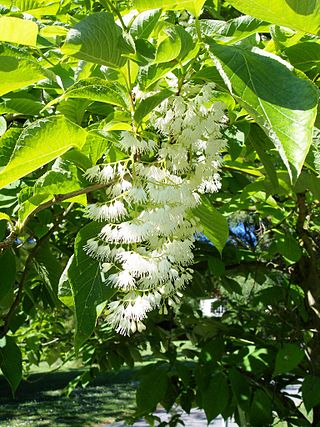
Pterostyrax, the epaulette tree, is a small genus of four species of deciduous large shrubs or small trees in the family Styracaceae, native to eastern Asia in China and Japan. They grow 4–12 m (13–39 ft) tall, with alternate, simple ovate leaves 6–17 cm (2–7 in) long and 4–10 cm (2–4 in) broad. The flowers are white, produced in dense panicles 8–25 cm (3–10 in) long. The fruit is an oblong dry drupe, with longitudinal ribs or narrow wings.
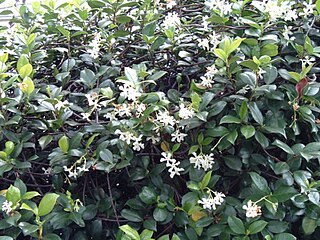
Trachelospermumstar jasmine, Confederate jasmine, is a genus of evergreen woody vines in the dogbane family Apocynaceae, first described as a genus in 1851. All species are native to southern and eastern Asia.

Actinidia arguta, the hardy kiwi, is a perennial vine native to Japan, Korea, Northern China, and the Russian Far East. It produces a small kiwifruit without the hair-like fiber covering the outside, unlike most other species of the genus.

Schoepfia is a genus of small hemiparasitic trees, flowering plants belonging to the family Schoepfiaceae. The genus has long been placed in the Olacaceae family.

Trochodendron aralioides, sometimes colloquially called wheel tree, is a flowering plant and the sole living species in the genus Trochodendron, which also includes several extinct species. It was also often considered the sole species in the family Trochodendraceae, though botanists now include the distinct genus Tetracentron in the same family. T. aralioides is native to Japan, southern Korea and Taiwan. Growing in lower temperate montane mixed forests in Japan, and broad-leaved evergreen forest in the central mountain ranges and Northern parts of Taiwan.
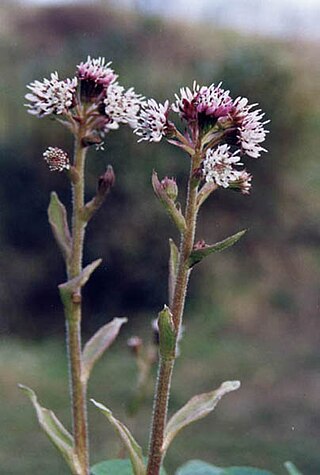
Petasites pyrenaicus, the winter heliotrope, is a medicinal and ornamental flowering plant in the family Asteraceae.
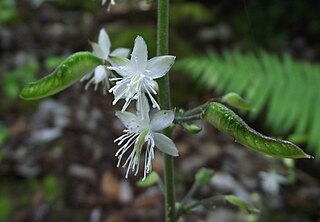
Beesia is a genus of flowering plants in the buttercup family. It was named in 1915 after the plant nursery firm Bees of Chester, who financed the plant hunting trips of George Forrest and Frank Kingdon-Ward in China.

Trachelospermum asiaticum, the Asiatic jasmine, is a species of flowering plant in the family Apocynaceae and it is native to Asia. Its flowers resemble stars, so it is also referred to as yellow star jasmine or Asian star jasmine. This is a fast growing evergreen vine, often used to cover fences, walls, and similar surfaces. It is heat- and cold- tolerant, and grows even in shady areas.
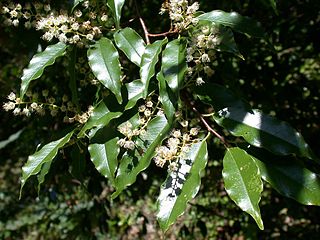
Prunus spinulosa is an evergreen species of cherry-laurel native to southeastern China and warmer parts of Japan. Its lustrous leaves superficially resemble those of holly. Individual trees can reach 20 m, and are typically found growing in places with high ambient humidity, such as forested areas near larger rivers.

Antidesma japonicum is a shrub in the family Phyllanthaceae. It is found in Southeast Asia, China and Japan. It provides food and fuel. A. japonicum has two accepted varieties: the nominate variety, A. japonicum var. japonicum; and the robustius variety, A. japonicum var. robustius.

Acer distylum, the lime-leaved maple or linden leaved maple, is a species of flowering plant in the family Sapindaceae, native to north Honshu Island of Japan. Its closest relative is Acer nipponicum, with which it is grouped in the Acer section Parviflora. The species is noted for its 10–15 cm (4–6 in) unlobed leaves, the like of which are not found in any other maple species. The bark is grayish, and has a pink cast in young specimens. Acer distylum was first described by Philipp Franz von Siebold and Joseph Gerhard Zuccarini in 1845, and later brought to Europe by Charles Maries in 1879.

Eriocapitella japonica is a species of flowering plant in the buttercup family Ranunculaceae. The specific epithet japonica means "from Japan", which is a misnomer since the species is introduced in Japan. It is native to China, Taiwan, and Vietnam.

Schizocodon is a genus of flowering plants belonging to the family Diapensiaceae.
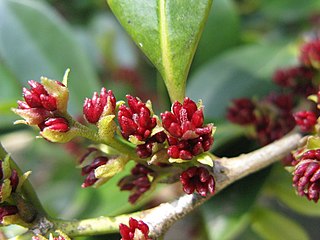
Distylium racemosum, the isu tree, is a species of flowering plant in the family Hamamelidaceae. It is native to subtropical eastern Asia; central and southern Japan, the Ryukyu Islands, South Korea, southeastern China, Taiwan, Hainan, and northern Vietnam. There are a number of cultivars, including 'Guppy' and the variegated 'Akebono'.

Carpinus laxiflora, the aka-shide, loose-flower hornbeam, or loose-flowered hornbeam, is a species of flowering plant in the family Betulaceae, native to the Korean Peninsula, and Japan. A deciduous tree of mountain forests, and typically 10 to 15 m tall, it is used in bonsai, and rarely as a park or street tree. It is available from commercial suppliers. In addition to the rather rustic unimproved species, a weeping form called 'Pendula', and a sport with variegated leaves called 'Variegata' are available.

Euptelea polyandra is a species of flowering plant in the family Eupteleaceae, native to wet areas of central and southern Japan. A suckering small tree, occasionally a many-stemmed shrub, it is used as a street tree in a number of European cities.





















